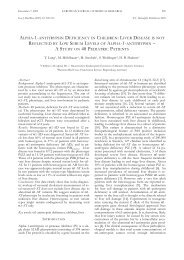European Journal of Medical Research - Deutsche AIDS ...
European Journal of Medical Research - Deutsche AIDS ...
European Journal of Medical Research - Deutsche AIDS ...
Create successful ePaper yourself
Turn your PDF publications into a flip-book with our unique Google optimized e-Paper software.
June 27, 2007 EUROPEAN JOURNAL OF MEDICAL RESEARCH<br />
59<br />
und einer antiretroviralen Behandlung zugeführt (non-<strong>AIDS</strong><br />
und <strong>AIDS</strong> Patienten ohne/mit Therapie). Neuropsychologische<br />
Tests und eine Lumbalpunktion wurden durchgeführt und<br />
Zytokinspiegel im Liquor mit einem speziellen Antikörper-<br />
Chip bestimmt.<br />
Ergebnisse: Alle Patienten unterschieden sich nicht hinsichtlich<br />
ihres Alters und der CD4-Zellzahl. Die Viruslast war<br />
bei allen behandelten Patienten im Blut und Liquor nicht<br />
nachweisbar. Unbehandelte Frühstadienpatienten zeigten<br />
schlechte Testergebnisse im Digit-Symbol-Test, dem Trail-<br />
Making-Test und der Feinmotorikanalyse bei hohen Liquorspiegeln<br />
von IL-4, IL-5 and GRO; behandelte Frühstadienpatienten<br />
hatten bei hohen Spiegeln von pro-inflammatorischen<br />
Zytokinen signifikant schlechtere Ergebnisse in der HIV-Demenz<br />
Skala. Behandelte <strong>AIDS</strong> Patienten zeigen dagegen bei<br />
hohen Spiegeln von ALCAM (CD166), Fas (CD95) und IL-<br />
18 bessere Ergebnisse in der HIV-Demenz-Skala.<br />
Diskussion: Die Studie konnte einen schwachen Zusammenhang<br />
zwischen entzündlichen Reaktionen und neuropsychologischen<br />
Defiziten im Zentralnervensystem von HIV-Patienten<br />
mit oder ohne antiretrovirale Therapie feststellen. Interessant<br />
ist, dass es <strong>of</strong>fensichtlich einen frühzeitigen, direkt virusvermittelten<br />
Schaden bei hoher Virusreplikation gibt, der durch<br />
eine antiretrovirale Therapie nur unvollständig positive beeinflussbar<br />
ist. In späten Stadien ist eine Virusreplikation unterhalb<br />
der derzeitigen Nachweisbarkeitsgrenze in Zusammenhang<br />
mit einer autoimmunologischen Dysfunktion des Immunsystems<br />
als Mediator der fortschreitenden neuropsychologischen<br />
Defizite wahrscheinlich.<br />
B.18 (Vortrag)<br />
Impact <strong>of</strong> depression on overall and health related<br />
Quality <strong>of</strong> Life (QoL) in HIV- and cancer-patients<br />
Wulff W. 1 , K<strong>of</strong>ahl-Krause D. 2 , Stoll M. 1 , Schmidt R.E. 1<br />
1 <strong>Medical</strong> School Hanover, Clinical Immunology, Hannover,<br />
Germany, 2<strong>Medical</strong> School Hanover, Haematology,<br />
Haemostaseology and Oncology, Hannover, Germany<br />
Aims: The estimates for lifetime prevalence <strong>of</strong> depression in<br />
HIV patients differ between 22 and 45% compared to appr.<br />
15% in non HIV infected people (1). Also in cancer patients<br />
published prevalences <strong>of</strong> depression range between 1,5 and<br />
53% (2). The impact <strong>of</strong> depression on overall or health related<br />
QoL in these groups is very plausible but not well established.<br />
HIV- and cancer-Patients were assessed by different tools for<br />
QoL, depression and personality.<br />
Methods: 50 HIV- and 54 cancer-Patients were assessed for<br />
their overall QoL with the SEIQoL-DW interview (3) and the<br />
MLDL questionnaire (4) and for their health related QoL with<br />
the SF-36 questionnaire (5). Depression was assessed with the<br />
BDI questionnaire (6) and personality with the FPI-R inventory<br />
(7). Stepwise regression analyses were performed.<br />
Results: (See Table 1)<br />
Referring to the health related QoL depression is the first<br />
factor for both HIV and cancer patients in the subscale health<br />
perception explaining 40.6% <strong>of</strong> variance (HIV patients) and<br />
39.8% (cancer patients). In the category mental health depression<br />
is the first factor for the HIV group explaining 52.5% <strong>of</strong><br />
variance, but for the cancer group BDI-depression is only the<br />
second factor explaining 12.2% <strong>of</strong> variance behind the the<br />
first factor FPI-emotionality with 49.0%. The models for all<br />
other subscales do not include BDI-depression or show it only<br />
as the second or third factor explaining minor percentages <strong>of</strong><br />
variance.<br />
Conclusions: Depression substantially influences QoL in<br />
both HIV and cancer patients. The overall QoL seemed to be<br />
even more affected than health related QoL. Regarding their<br />
mental health HIV patients are more affected by depression<br />
than cancer patients.<br />
Remarks: 1 Himmelhoch et.al. 2005; 2 Trask 2004; 3 Boyle et.al.<br />
1993; 4 v.Steinbüchel et.al. 1993; 5 Bullinger, Kirchberger 1998;<br />
6 Hautzinger et.al. 1995; 7 Fahrenberg et.al. 2001<br />
B.19 (Poster)<br />
Management <strong>of</strong> a HIV-exposed pregnancy with<br />
twin-to-twin transfusion syndrome (TTTS)<br />
Kost B.P. 1 , Kästner R. 1 , Sovric M. 1 , Kainer F. 1 ,<br />
Gingelmaier A. 1<br />
1 I.UFK, LMU München, Frauenklinik-Innenstadt, München,<br />
Germany<br />
Objectives: Options and risks <strong>of</strong> an invasive intervention<br />
(laser photocoagulation) in twin-to-twin transfusion syndrome<br />
(TTTS) and HIV-infection in pregnancy.<br />
Method: A case report<br />
Results: HIV infection <strong>of</strong> a 27 year old III-para I-para with<br />
monozygotic, diamniotic twins was diagnosed external in the<br />
9th week <strong>of</strong> gestation. At that time no indication for antiretroviral<br />
treatment was seen (viral load 2600 cp/ml, CD4 510<br />
cells/l). In the 19+2 week <strong>of</strong> gestation a pronounced TTTS<br />
with pathological color duplex sonography <strong>of</strong> the donor (195g)<br />
and the acceptor (326g) with a massive polyhydramnion was<br />
established. Concerning the wack prognosis the indication for a<br />
laser photocoagulation was set. To reduce the risk <strong>of</strong> a vertical<br />
HIV transmission a antiretroviral therapy with Kaletra and Tru-<br />
Table 1





